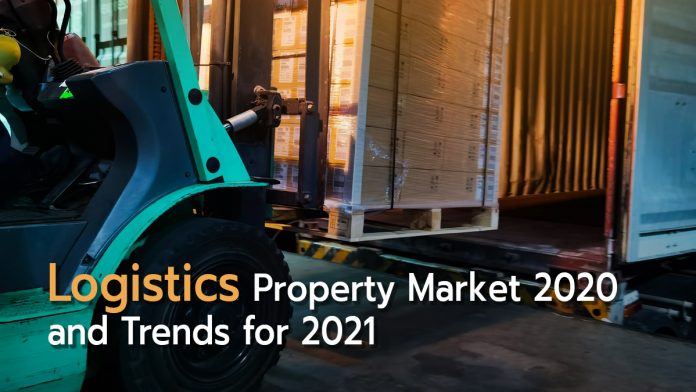
Mr. Marcus Burtenshaw, Executive Director and Head of Occupier Services and Commercial Agency (OSCA), Knight Frank Thailand, said that “Thailand is the second largest economy in ASEAN and has one of the largest online populations in the region, with almost 60 million active internet savvy users. So it came as no surprise to see demand from the eCommerce sector continue to grow over the past year, as platforms such as Lazada, Shoppee, Rakuten, and 11Street found an increasingly receptive user base in the country.
This growth, spurred in part by the pandemic, continues to be a significant demand driver for warehousing space, not just from the platforms themselves but also for their last mile delivery partners, such as Thailand’s homegrown unicorn Flash Express. This three-year-old company is now valued at over 1 billion US$, after recently securing over US$150 million in series D&E funding, helping them to grow to over 5,000 delivery points throughout the country, from which they deliver over one million parcels per day.
However, the story the logistics market in Thailand is much more than just one sector. We expect to see growth throughout the logistics market in 2021 as countries around the globe emerge from under the shadow of Covid-19, the World Trade Organisation predicts a rebound in global trade as demand for goods could grow by as much as 8% in 2021, after falling 5.3% in 2020, with electronic goods (a key export for Thailand) being in high demand.”
Logistics Property Market Indicators

Economic Overview
In Q4 2020, the GDP of Thailand declined by 4.2% Y-o-Y, improving from a 6.4% contraction recorded in the previous quarter. For the full year, the Thai economy contracted by 6.1% after it had expanded by 2.3% in 2019.
Private consumption expenditure increased by 0.9%, improving from a 0.6% contraction recorded in Q3 because of the implementation of government economic stimulus packages. Government spending rose by 1.9% due to increases in both the purchase of goods and services and employee compensation. The government budget disbursement rate also improved. Total investment fell by 2.5% following a 2.6% decline in the previous quarter.
Private investment decreased by 3.3%, rising from a 10.6% contraction on the previous quarter. Meanwhile, public investment rose by 0.6%, falling from a 17.6% expansion in Q3 as investments by state-owned enterprises fell by 21.8%. Exports and Imports of goods and services dropped by 21.4% and 7.0% respectively. Merchandise exports contracted by 1.5%, improving from a 7.5% fall in Q3 as exports of rice, rubber and electronic products increased following the relaxation of lockdown procedures and the provision of economic stimulus packages in some trading partner nations.
On the production side, the transport and storage sector fell by 21.1% in Q4, continuing from a 22.2% drop in the previous quarter. Air transport, land and tube transport and water transport services declined by 68.1%, 12.7% and 17.7% respectively. Meanwhile, shipping support services contracted by 22.1%.
Nevertheless, postal services expanded, increasing by 27.2%. The number of shipping containers that passed through Laem Chabang port in 2020 fell by 6%, dropping to 7.6 million TEU. The number of containers dropped both inbound and outbound, reflecting the decline in export and import activity and the global shipping container shortage. Many containers have found themselves in inland depots while others have been stacking up at cargo ports. Because of national lockdown restrictions, these containers have not been shipped to countries that have resumed trading activity, leading to the shortage. It is estimated that Thailand had a shortage of 1.5 million containers in 2020.
Supply
Based on Knight Frank Thailand Research, In H2 2020, the total supply of ready-built warehouses in Thailand increased by 0.7% H-o-H to reach 4.57 million sq m. For the full year, total supply increased by 2.5%. Despite supply chain disruptions caused by the COVID-19 pandemic, developers in the market generally build based on real demand and have already slowed down new ready-built warehouse project launches over the past few years, leading to low likelihood of oversupply.
Figure 1
Thailand Ready-Built Warehouse Supply
Sq m

Given the sustained poor global and domestic economic conditions in combination with existing vacancies in the market, many developers may have prioritized maintaining and improving current stock performance over launching new projects unless they received clear and substantial interest from tenants beforehand.
Supply Distribution
Warehouses in Thailand are heavily concentrated in regions which provide unique advantages from a logistics standpoint. The region with the largest market share is the Bangkok metropolitan region, with the focal points being Bangkok and Samut Prakan. Bangkok is the economic pinnacle of Thailand, contributing to around 30% of the country’s GDP. Meanwhile, Samut Prakan acts as important link between Bangkok, the Suvarnabhumi Airport, and the Eastern Economic Corridor (EEC) region. Around 2.07 million sq m of total warehouse supply is in the Bangkok metropolitan region, representing a 45.3% market share. A stimulated e-commerce market and the corresponding growth in last-mile logistics continued to drive growth in the Bangkok metropolitan region’s logistics property market.
However, new supply was limited in the 2nd half of the year as supply increased by only 0.1% H-o-H. The eastern seaboard contains the 2nd largest market share at 38.0%. The region benefits from its importance as a manufacturing and distribution hub, as well as its special designation as the EEC linked with many investment privileges. Total supply in the Eastern seaboard increased by 0.8% H-o-H. Meanwhile, the supply in the central region expanded the most, increasing by 2.4% H-o-H to attain a 16.2% market share.
Figure 2
Thailand Ready-Built Warehouse Distribution by Region

Demand
Leasing activity picked up to a limited extent in H2 2020. Take up increased by 60.8% to 133,000 sq m from around 83,000 sq m in the first half. Nevertheless, the level is still far below the 5-year average level of take up at 207,600 sq m. Subsequently, net absorption increased to 50,000 sq m from 18,000 sq m. The positive market growth signifies the logistic property market’s resilience in the face of disruptions caused by the COVID-19 pandemic. Market demand rose albeit at a much slower pace than in previous years. Total occupied space increased by 1.8% H-o-H to 3.83 million sq m due to the positive level of net absorption. Demand has been driven primarily by E-commerce and 3rd party logistics (3PL) players who have benefited significantly from the rapid adoption of technology somewhat at the expense of traditional brick-and-mortar retail. Another demand driver was from exporters who have been affected by the container shortage as carriers prioritized neighboring countries such as China or Vietnam. Some developers have been quick to capitalize by entering short term contracts with affected tenants to provide storage space for goods awaiting shipment.
Nevertheless, demand continued to shift towards built-to-suit warehouses as tenant requirements are increasingly specific and operational efficiency is valued over pure rental cost savings. Built-to-suit warehouses enable developers to mitigate occupancy risk because the lease agreement is signed prior to the construction of the project, and tenants are likely to renew the lease term as there are limited alternatives elsewhere. In addition, built-to-suit warehouse leases are long-term leases that enable the developer to secure a steady flow of rental income and accurately make financial forecasts. Frasers Property and WHA, the two largest developers by market share, have both underlined a stronger focus on increasing their Built-to-Suit development projects and combined have committed to over 200,000 sq m of BTS logistics developments for 2021.
Figure 3
Thailand Ready-Built Warehouse Supply-Demand Dynamics
Sq m

Figure 4
Thailand Ready-Built Supply, Demand & Occupancy Rate
Sq m

As net absorption exceeded supply growth, the market occupancy rate increased by 0.5% points from the previous half to 83.7%. The Bangkok Metropolitan Region was the only area in which the occupancy rate increased, with the rate rising by 1.5% points to reach 91.1%. The occupancy rate declined slightly for both the Eastern Seaboard and the central region, dropping by 0.2% and 0.4% respectively.
Table 1
Thailand Ready-Built Warehouse Occupancy Rate by Region

Rental Rates
The average asking rent for warehouses in Thailand increased minimally to 158 baht per sq m per month. Over the past decade, the asking rent has increased by only 3 baht. Given the existing vacancy level and minimal difference in the standard ready-built warehouse characteristics, major increases in market rent may be difficult to justify. On the other hand, rather than decrease the asking rent to counter the drop in demand caused by COVID-19, major developers have elected to grant rental deferments or rebates for existing tenants.
On a regional basis, the asking rent increased minimally in the Bangkok metropolitan and the Eastern Seaboard, increasing by 0.1% H-o-H and 0.2% H-o-H, respectively. The asking rent increased the most for the central region, rising by 1.8%.
Figure 5
Thailand Ready-Built Warehouse Average Asking Rent by Region
Baht per sq m per month

Although there was a noticeable difference in average asking rents, the rental spread was quite similar across the various regions. The most expensive warehouses commanded up to twice as much as their cheapest counterparts, leading to a wide rental spread of 80 baht to 100 baht. It indicates that in all 3 regions, there are warehouses of various qualities ranging from older, competitively priced properties to newer, ‘premium’ warehouses catering to different segments of tenants.
Figure 6
Thailand Warehouse Average Rent Spreads
Baht per sq m per month

Outlook
The logistics property market proved resilient in H2 2020 despite the prolonged effects of the COVID-19 pandemic on the Thai economy and global supply chain. As predicted, leasing activity did pick up but at a subdued level in the latter half of this year as production resumed and firms implemented revised real estate strategies based on the current and projected impact of the pandemic on their business operations. If the spread of COVID-19 can be controlled and vaccinations are rolled out as planned, we expect demand to continue picking up throughout 2021.
The accelerated growth of the e-commerce sector and 3PL logistics providers drove most of the positive leasing activity in 2020. The new demand will continue to grow and offset demand lost from pure offline retail sources. The area that stands to benefit the most from the change in consumer patterns will most likely be the Bangkok metropolitan region due to Bangkok’s status as the economic engine of Thailand and the growing importance of last-mile logistics. The increase in the occupancy rate for ready-built warehouses in the region despite challenges posed by the pandemic this year is a good indication of resilient demand. If the container shortage persists, there may be some additional short-term demand for warehousing as exporters take time to adapt and adjust their inventory holdings accordingly.
Built-to-Suit logistics properties will continue to grow in market share. There will also be greater differentiation between the type of BTS solutions provided, with varying levels of technology implementation. Properties in the BTS pipeline for 2021 range from regional distribution centers to cold storage facilities and fully automated warehouses.
As speculative building is limited, there is low likelihood of oversupply going forward unless the situation worsens and a significant number of firms are forced to shut down. As a result, the average asking rent is expected to remain constant while the occupancy rate of ready-built warehouses rises at a gradual pace over the next year.



















